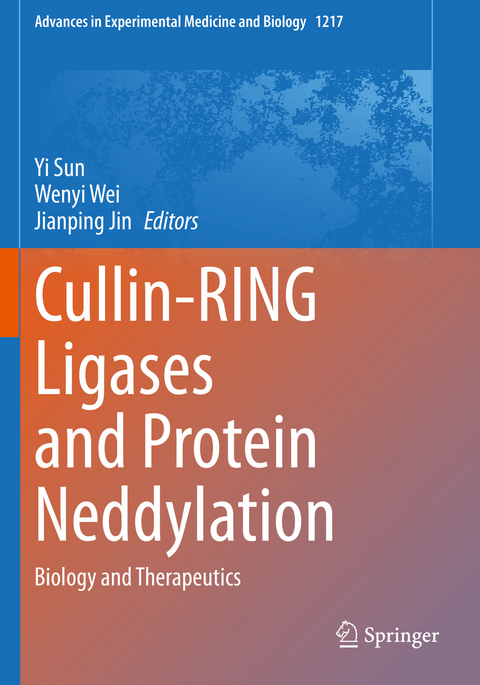
Cullin-RING Ligases and Protein Neddylation
Springer Verlag, Singapore
978-981-15-1027-4 (ISBN)
Dr. Yi Sun completed his medical training in China in the early 1980s, his Ph.D. at the University of Iowa, USA, in 1989, and his postdoctorate at the NCI. Currently, he is a Lawrence-Krause Research Professor of Radiation Oncology, and Director of the Division of Radiation & Cancer Biology, Department of Radiation Oncology at the University of Michigan. His main research aims are validating SAG-Cullin RING Ligase (CRL) and neddylation as cancer targets, and identifying small molecule inhibitors against these targets for anticancer therapy. Dr. Sun is the author of 222 peer- reviewed articles published in various prestigious journals, including Dev Cell, eLife, J Cell Biol, J Clin Invest,Mol Cell,Nature Communications, PNAS, and Cancer Res. He serves as editorial board member of several scientific journals. He was elected as a fellow of the AAAS (American Association for the Advancement of Science) in 2012. Dr. Wenyi Wei received his B.A. degree from Shandong University in 1993 and pursued his M.S. at the Chinese Academy of Science from 1993 to 1996. Afterwards, Dr. Wei completed his Ph.D. at the MCB department at Brown University and his postdoctorate at the laboratory of Dr. William Kaelin, Jr. at DFCI, Harvard Medical School. In 2006, Dr. Wei moved to the Department Pathology at Beth Israel Deaconess Medical Center, Harvard Medical School, where his research focuses on understanding how aberrant cell signaling events contribute to cell cycle dysregulation and subsequent tumorigenesis, to provide the molecular basis and the rationale to develop novel anti-cancer therapies targeting specific cell signaling pathways. Dr. Jianping Jin completed his PhD at Texas A&M University at College Station in 2000, and his postdoctorate in Dr. J Wade Harper’s Laboratory at Baylor College of Medicine and then at Harvard Medical School. Currently, he is a Professor and senior investigatorat the Life Science Institute, Zhejiang University, China. His main research projects focus on the ubiquitin signaling pathway, and its roles in cancer and inflammation. He discovered Uba6, the second ubiquitin E1 gene (humans only have two ubiquitin E1 genes), and its specific E2 gene, Use1 (also called Ube2Z). He was among the first to identify the family of DCAF genes, which are substarte adaptors of the Cullin4 ubiquitin ligases. Dr. Jin has published more than 50 peer-reviewed articles, and serves as an editorial member of the Journal of Biological Chemistry. He was a co-organizer for three Cold Spring Harbor Asia meetings on the ubiquitin family.
Chapter 1 Introduction of Protein Ubiquitination and Cullin/RING Ubiquitin Ligases: introduce the protein ubiquitination system briefly; discuss the family of Cullin/RING Ubiquitin Ligases.- Chapter 2 Assembly and Regulation of CRL ubiquitin ligases: discuss the assembly process of CRL ubiquitin ligases by CAND1; elaborate the regulation of CRL ubiquitin ligases by neddylation.- Chapter 3 Protein structure of CRL and Neddylation complex.- Chapter 4 The roles of CRL ubiquitin ligases and neddylation in human diseases.- Chapter 5 The roles of CRL ubiquitin ligases in stem cell biology: Briefly introduce concept and potential application of stem cells; analyze a few example for CRL ubiquitin ligases to control stem cell biology.- Chapter 6 The biology of F-box proteins: introduce the history of SCF ubiquitin ligases; discuss the overall functions of F-box proteins (emphasize phospho-degron concept).- Chapter 7 The roles of Fbxw7 in human diseases: discuss the roles of Fbw7 in cancer; elaborate the roles of Fbxw7 in other diseases.- Chapter 8 Mouse models of CRL1 components to study their biological function.- Chapter 9 Cullin2 and cancer: introduce Cullin2 ubiquitin ligases; discuss VHL ubiquitin ligase and its roles in cancer.- Chapter 10 Cullin3 and tumorigenesis: introduce Cullin3 ubiquitin ligases; discuss a few examples of Cullin3 ubiquitin ligases in control of tumorigenesis.- Chapter 11 Cullin4-DCAF proteins in tumorigenesis: Discovery of DCAF proteins; discuss a few examples of DCAF’s biological functions.- Chapter 12 Cullin4 ubiquitin ligases in DNA damage responses: Introduce Cullin4 ubiquitin ligases; discuss the roles of Cullin4 ubiquitin ligases in DNA damage responses.- Chapter 13 Coordinating the roles of Cullin5 ubiquitin ligases by SAG and UBE2F: introduce Cullin5 ubiquitin ligases; discuss how SGA and UBE2F mediates the functions of Cullin5.- Chapter 14 Cullin5 in anti-virus infection: mechanism and drug target.- Chapter 15 The roles of Cul7 in cancerbiology: introduce Cullin7 ubiquitin ligase7; discuss a few examples of Cullin7 ubiquitin ligases in cancer.- Chapter 16 Coordinating functions of p97 and CRL ubiquitin ligases in protein turnover: introduce the interactions between p97 and CRL ubiquitin ligases; discuss the coordinating roles between p97 and CRL ubiquitin ligases in protein turnover.- Chapter 17 Interaction between CRL ubiquitin ligases and COP9 Signalosome: introduce Cop9 signalosome; discuss how Cop9 signalosome regulates CRL ubiquitin ligases.- Chapter 18 Drug discovery effort to target Cullin-3 neddylation: discuss inhibitor of Cullin3 neddylation and its application.- Chapter 19 Targeting neddylation modification: Briefly introduce protein neddylation; discuss the roles of neddylation in cancer.- Chapter 20 Targeting CRL ubiquitin ligases: discuss current progress in targeting CRL ubiquitin ligases; discuss the application of CRL ubiquitin ligases in Protac drug development.
| Erscheinungsdatum | 15.01.2021 |
|---|---|
| Reihe/Serie | Advances in Experimental Medicine and Biology ; 1217 |
| Zusatzinfo | 68 Illustrations, color; 51 Illustrations, black and white; VIII, 372 p. 119 illus., 68 illus. in color. |
| Verlagsort | Singapore |
| Sprache | englisch |
| Maße | 178 x 254 mm |
| Themenwelt | Medizin / Pharmazie ► Studium |
| Naturwissenschaften ► Biologie ► Biochemie | |
| Naturwissenschaften ► Biologie ► Zellbiologie | |
| Schlagworte | CRLs • Cullin-RING ligases • Protein degradation • protein neddylation • protein ubiquitylation • targeted therapy |
| ISBN-10 | 981-15-1027-X / 981151027X |
| ISBN-13 | 978-981-15-1027-4 / 9789811510274 |
| Zustand | Neuware |
| Haben Sie eine Frage zum Produkt? |
aus dem Bereich


